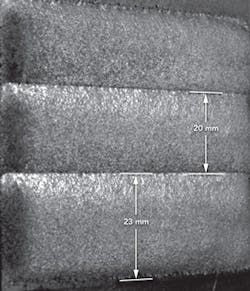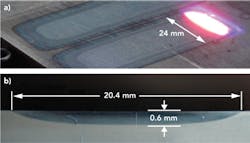Keith Parker
Higher output power and customized beam shapes substantially improve heat treating and cladding
Lasers have been effectively employed for several years for surface treatment applications of heat treating and cladding of metal surfaces. Recent advances in direct-diode laser design now deliver substantially better results for these applications. In particular, higher laser output power, combined with more flexible beam-shaping optics, have resulted in significantly increased product throughput. Higher laser efficiencies also minimize operating costs. This article reviews the key characteristics of current high-power direct-diode lasers and optimized beam-shape optics, and presents quantitative test results that verify the process improvements that these lasers can deliver.
Background
Cladding and heat treating (hardening) are processes used on metal parts to improve their surface properties, such as resistance to mechanical wear or corrosion. Cladding involves melting a material, usually supplied in powder or wire form, onto a part to create a metallurgically bonded surface layer having a different composition than the base material. In contrast, hardening entails quickly heating the surface of the base material and then rapidly cooling it in order to change its crystalline form, making it substantially harder (but more brittle) than the base material.
Lasers provide a very effective means for producing the highly localized heating necessary to accomplish both cladding and heat treating. High-power laser diode systems in particular are well-matched to the needs of this application for several reasons. First, their near-infrared wavelength is relatively well absorbed by most metals. Also, the conversion of electricity into laser light is inherently more efficient with semiconductors than for any other laser medium. For example, a diode laser system might have a total conversion efficiency of 50% (electrical input to light delivered at the workpiece), while even an efficient fiber laser converts only 35% of its input into light. Finally, the naturally rectangular-shaped output beam from a diode laser array is well matched to the needs of large-area applications. In particular, the rectangular cross-section of the diode laser array output can be easily re-imaged to a line of laser light. This line is then scanned across the surface in a direction perpendicular to its long axis to enable rapid processing of large areas. This eliminates the need encountered with other lasers to employ an optical system to transform (with some inevitable losses) a small round beam into a large, rectangular shape.
Laser advances
In the past, most high-power diode laser cladding has been performed with systems having output power in the 1–4 kW range. One significant advance in diode laser technology has been to push this output level to 8 kW through a number of incremental improvements. These include the use of more efficient power supplies which are specifically configured to act as constant current (rather than voltage) sources, as well as advances in the semiconductor materials and cooling methods. The result is the ability to derive greater output power than previously available from a given form factor device. Most importantly, this power has been achieved while retaining the inherent high efficiency of the semiconductor laser source.
A significant practical advance for large-area cladding and heat treating applications has been the development of modular beam-shaping optics that enable the beam dimensions at the work piece to be precisely matched to the process requirements. For example, Coherent’s flexible implementation is accomplished by a set of optics that can be rapidly changed, literally without the use of any tools. Two different sets of optics are employed: one to change the length of the beam, and another to alter the beam width. Thus, the nominal output from the Coherent laser (the 8 kW output model) is 1 mm wide by 12 mm long. Two different beam optics modules can change this length to either 24 mm or 6 mm. A separate set of optics enable expansion of the 1 mm width to 3 mm, 6 mm, 8 mm, or 12 mm. These can be combined to achieve a total of 15 different beam shapes. Furthermore, all these optics are configured to maintain a constant working distance (from laser to focal plane), so that changing the beam shape does not necessitate any other setup changes.
Another significant improvement in high-power diode laser implementation is the use of closed-loop pyrometer control. Specifically, an optical pyrometer is used to measure the temperature of the work piece within the laser interaction zone. For the aforementioned unit, this is accomplished by sampling two separate wavelengths to enable absolute, rather than simply relative temperature measurement. The pyrometer signal is then used as a feedback to control laser driver current so as to maintain a constant temperature on the workpiece.
The ability to hold a constant process temperature delivers more consistent results and maximizes system efficiency. In particular, it enables the system to automatically compensate for changes in part thickness (which affects the ability of the workpiece to conduct heat away from the interaction zone), variations in the bulk material, or changes in the relative speed of the beam with respect to the part. The latter is particularly important because relative beam speed usually changes when part motion goes through a 90° or 180° turn. In the past, determining the exact parameters needed to maintain constant temperature during such a turn usually required lengthy advance experimentation, and limited the ability to accommodate later alterations to processing geometry. All this setup time is eliminated by pyrometer control since constant temperature is maintained on the fly while flexibility is maximized.
Improved process results
A study examined the effects of laser power and line beam size on effective throughput for both cladding and heat treating, which produced surprising results. In the first experiment (FIGURE 1), the time required to clad a 1 m2 area continuously with a constant thickness of material, utilizing various different laser powers and line beam sizes, was measured. Measuring the time required to clad a given area with a certain thickness, rather than just linear processing speed, is important because this incorporates all the process factors that come into play, and is ultimately the metric of concern to users.
As expected, the higher-power system required the shortest amount of time to clad the full 1 m2 area (TABLE 1). Specifically, at the highest power (7 kW and a 3 × 24 mm line beam with matching, co-axial cladding nozzle), it took 104 minutes to clad 1 m2. In contrast, processing the same area with 4 kW and a 1 × 12 mm line beam took 250 minutes. Clad quality was similar at both powers.
The unexpected aspect of the result is that, although the power increased by only a factor of 1.75 (4 kW to 7 kW), throughput increased by a factor of 2.5. This is 40% higher than expected from a linear power-to-throughput relationship. The key element in achieving this non-linear increase is altering the line beam width in order to make maximal use of the increased laser power.
A similar experiment was performed for large-area heat treating. The laser was operated at 7 kW, and optics were used to transform the length and width of the line beam to a final rectangular shape of 8 × 24 mm at the workpiece (FIGURE 2). To achieve a hardness of 61 HRC, a travel speed of 27 mm/s was chosen with the 7 kW system. This resulted in a heat-treated surface width of 20.4 mm, and a maximum case depth of 0.6 mm.
When operating at 4 kW, a 8 × 12 mm rectangular beam was utilized, with a travel speed of 17 mm/sec in order to achieve the same hardness within the same case depth. In this instance, the heat-treated surface width was only 13 mm, with a maximum case depth of 0.7 mm.
With a 1.6× faster travel speed, and a 1.6× wider heat treatment profile, the time needed to heat treat 1 m2 area is 2.6× shorter at 7 kW than at 4 kW (TABLE 2). Interestingly, this shows the same non-linear relationship between laser power and throughput as for the large area cladding experiment — namely, a power increase of only 1.75× resulted in a 2.6× faster throughput.
Conclusion
The combination of higher output power with easily customized beam shapes delivers a substantial improvement in results for large-area heat treating and high-throughput cladding. In particular, this provides the ability to use longest lines at which laser power is still sufficient to melt the clad material. This translates directly into maximum throughput for a given power. Similarly, for heat treating, laser power and line beam dimensions influence the rates of heating and cooling. Thus, the ability to set these parameters enables the resultant case depth and surface hardness properties to be precisely controlled. ✺
Keith Parker ([email protected]) is senior business development manager, direct diode and fiber laser systems, at Coherent Inc., Santa Clara, CA.
More Industrial Laser Solutions Current Issue Articles
More Industrial Laser Solutions Archives Issue Articles



